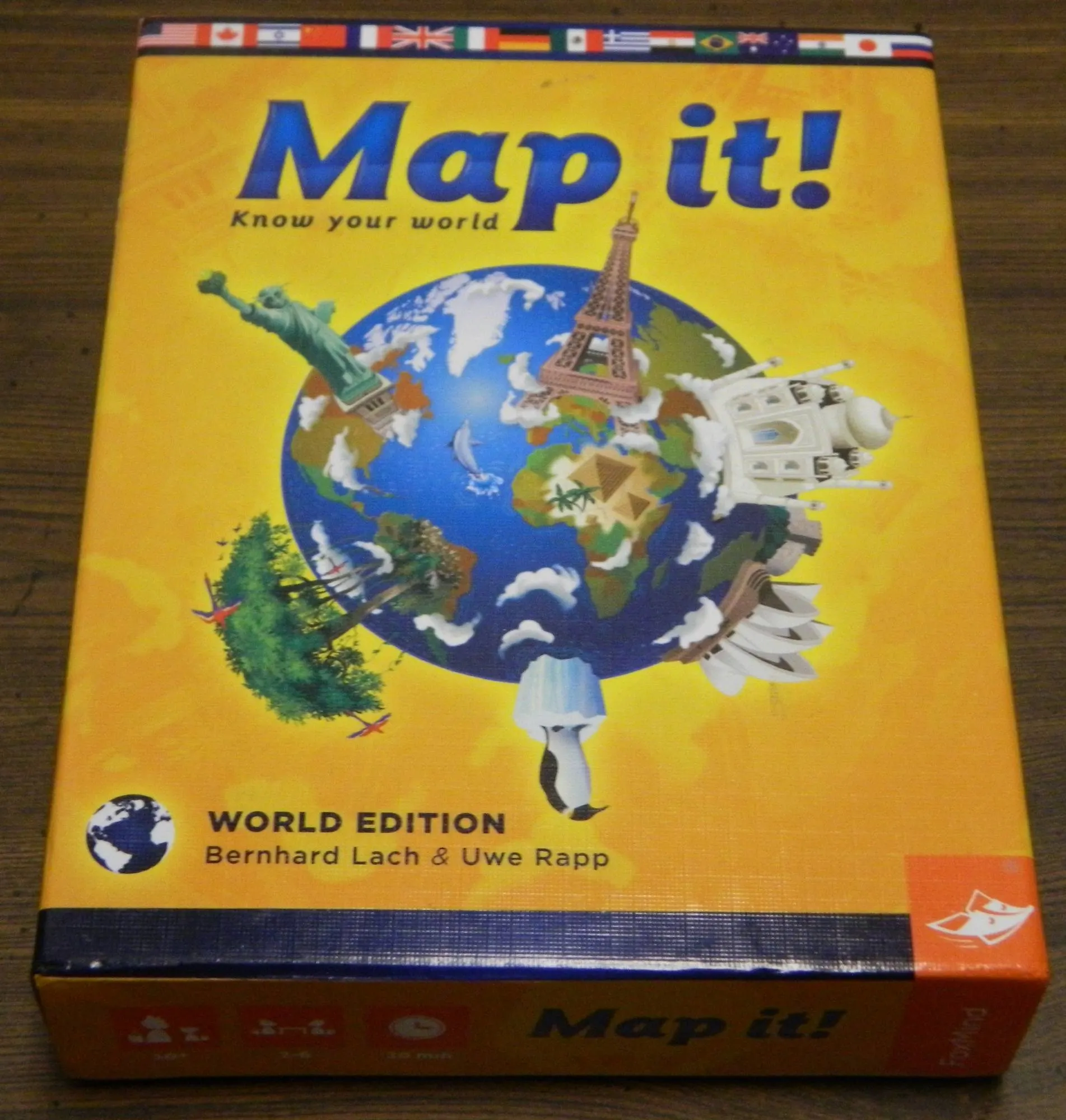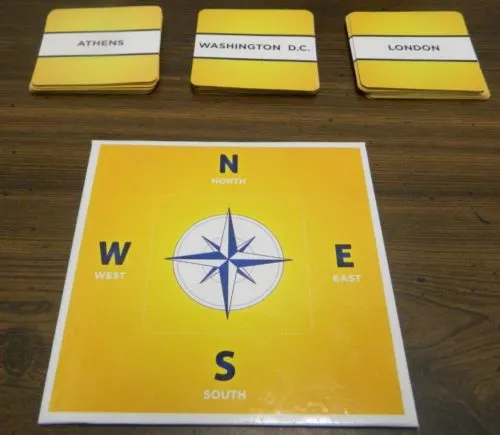Around three years ago we looked at the trivia game Chronology. When I first saw Chronology I barely gave it a second glance but after playing the game it became one of the more surprising board games that I had ever played. For those of you not familiar with the game, the basic premise of Chronology is that you draw cards that have historical events on them. Without looking at when the events occurred you had to place them in chronological order. This might not sound like much but Chronology is such a great game because it blends fun with education. I bring this up because when I first saw Map It! World Edition it immediately reminded me of Chronology but with geography. While I enjoy history more than geography, I was excited to see how Map It! World Edition would be able to adapt this type of gameplay to make it work for geography. Map It! Word Edition does a great job making an educational geography game fun but it does have some issues when it comes to scoring.
How to Play Map It! World Edition
Setup
- Place the compass rose card in the middle of the table.
- Each player takes four tokens.
- Choose whether you are going to use just the beginner cards or the beginner and expert cards. If you chose just the beginner cards, you will only use the cards that have a black bar above and below the city name. Shuffle the chosen cards.
- Separate the cards into three piles of fifteen cards.
- Choose one of the piles to start the game with. Set the other two piles aside for the second and third rounds. Take the top card from the chosen pile and place it in the center of the compass rose card. Set the other cards next to the compass rose card.
- Randomly determine which player will start the game.
Playing the Game
Playing A Card
On a player’s turn they take the top card from the current pile. Without looking at the back of the card the player has to decide whether the location on the cards is north, east, south or west of the card on the compass rose card. They will place the card in the corresponding direction relative to the center card. As long as no one challenges the placement, play passes to the next player clockwise.
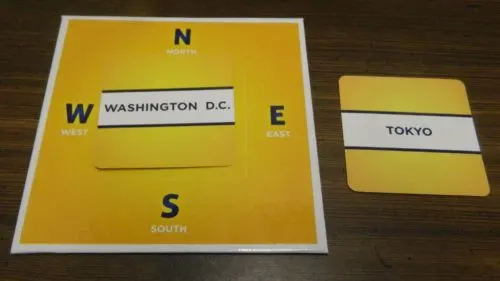
This player believes Tokyo is east of Washington D.C. so they place the card to the right of the middle card.
Each player takes turns placing the next card from the pile. All cards must be placed in accordance to all of the cards on the table.
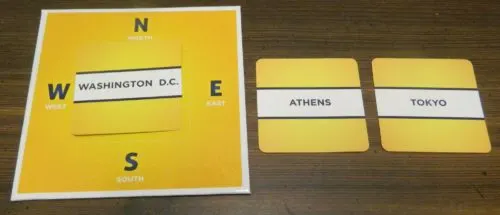
With the Tokyo card already on the table, this player decided to place the Athens card between Washington D.C. and Tokyo. This player believes that Athens is east of Washington D.C. and Tokyo is east of Athens.
Challenging A Card
After a player has played a card, the other players are able to challenge the position of the card if they believe it was placed incorrectly. Going clockwise around the table each player can choose whether to challenge or not. If one of the players challenge the placement they will flip over the card and one of the adjacent cards.
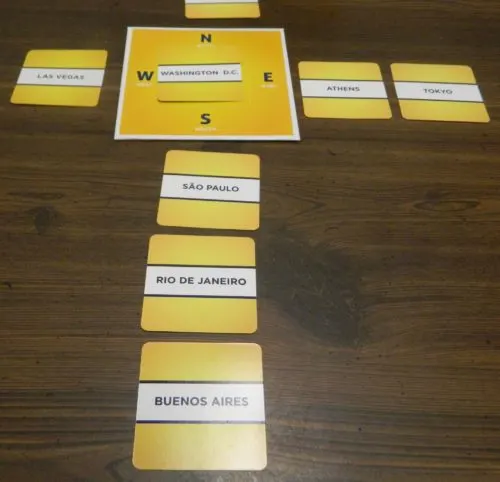
The current player has placed the Rio De Janeiro card below the Sao Paulo card. One of the players decide to challenge this placement as they think Rio De Janeiro is north of Sao Paulo.
To compare the cards use the white marks along the sides of the cards.
- To compare cards north to south, place the cards next to one another horizontally. The card whose line is further up on the card should have been placed above the other card.
- To compare cards east to west place one card above the other. Whichever card’s line is further left should have been placed to the left of the other card.
- If the lines are basically equal to one another, the players will have to compare the coordinates on the cards to see if the cards were placed correctly.
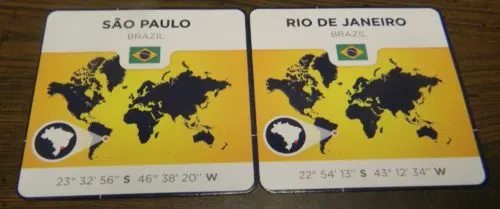
A player challenged the placement of the Rio De Janeiro card as they believed it is north of Sao Paulo. The players first compare the lines on the right/left side of the cards. Since the lines are practically at the same place, the players compare the coordinates. By comparing the coordinates they confirm that the challenger was correct that Rio De Janeiro is north of Sao Paulo.
If the card was placed incorrectly, the cards are flipped (unless one of the cards were the center card). The player who incorrectly placed the card will give one of their tokens to the challenging player. If the card was placed correctly the challenging player has to give one of their tokens to the player who placed the card.
End of Round
After all of the cards from one of the piles have been played, the round ends. All of the players will look at the cards that have been placed. Each player will predict how many cards they believe were placed incorrectly. At the same time each player holds up fingers equal to how many cards they think were placed incorrectly. The players will then compare all of the cards to see if they were placed correctly. The players will start with the center card and move one card at a time in each direction checking each card against the next card. If any cards were placed incorrectly they are removed from the table.
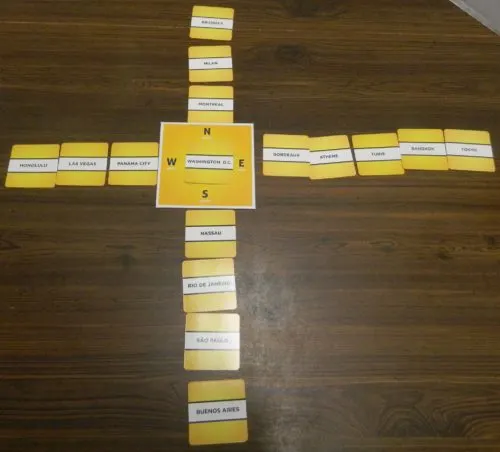
All of the cards for this round have been placed. Each player has to guess how many cards they think were misplaced.
Once all of the cards have been checked the players will count up how many were removed from the board. If any player(s) correctly guessed how many cards were placed incorrectly, they will take two tokens from the bank. If none of the players guessed correctly, the player(s) whose guess was closest will take one token from the bank.
All of the cards used in the round are discarded. The players choose one of the remaining piles and place the top card on the compass rose card and another round is played.
End of Game
The game ends when all three rounds have been finished. The players count up how many tokens they acquired in the game. The player with the most tokens wins the game.
My Thoughts on Map It! World Edition
In general educational board games don’t have the greatest reputation. Most of the time the games are more focused on being educational than actually being fun to play. For this reason I am always a little hesitant to play educational games. While there are still a lot of bad educational games, it seems like designers have started to get better at designing games that can be both educational and fun. With how much I enjoyed Chronology I was hoping that Map It! World Edition would also succeed in threading the needle between being educational while still being fun. For the most part I think Map It! World Edition succeeds in that task.
Basically the premise behind Map It! World Edition is for players to correctly place cities and landmarks in relation to one another. Players take a card that has a city or landmark on it and have to try and correctly place it north, south, east or west of one of the other cards already out on the table. This might not sound that educational at first but it has more to it than you would expect. In order to correctly place a card you need to know where the city/landmark is located along with all of the other cards that have already been played. You then have to figure out how to play your card in relation to all of the other cards. Map It! World Edition might not teach you about the locations themselves but I could see it working pretty well at teaching players the locations of cities from around the world.
In addition to being educational Map It! World Edition succeeds where many other educational games have failed. Instead of focusing on just being educational, the designers spent the time making sure the game was enjoyable as well. While the idea of placing a card in relation to other cards might seem simplistic, it is surprisingly fun as well. The mechanics are simple enough that anyone can enjoy them while also providing more challenge than you would think. The mechanics may not appeal to everyone but I thought they were quite fun. It is not a game that I would play for hours at a time but I can definitely see bringing out the game every so often and enjoying it every time.
With the game being entirely based on knowing where different locations are located on the map, your enjoyment and success in the game is going to come down to your knowledge and enjoyment of geography. If you hate geography I see no reason why you would enjoy Map It! World Edition. If your geography knowledge is kind of lacking you could still enjoy the game but you are likely going to struggle. You could always just guess where the card should be placed but you will likely be challenged quite a bit.
Map It! World Edition is definitely going to be challenging for people that don’t know their geography but I can even see it being challenging for people that know quite a bit of geography. I wouldn’t consider myself to be close to a geography expert but I would say that I am pretty knowledgeable about the topic. With that said I thought Map It! World Edition was still quite challenging at times. The challenge comes from a couple factors.
First there will be times where you get two cities/landmarks that are in the same country. As these locations are usually pretty close to one another, you will sometimes need to know exactly where in a country a city resides in order to place cards properly. While this is pretty easy in a large country or a country you are familiar with, you have to really know your geography to know exactly where in a country a city is located. Even when the cards are not from the same country it is sometimes hard to tell which one is farther north/south/east/west when the two cities are basically equal in one of the directions. You will encounter times where there are cities within one degree of one another and good luck knowing which one is slightly further in the direction than the other.
The second thing that adds difficulty to the game might have come from an error in the instructions. As I will discuss more later the English translation of the rules are not perfect, so I am wondering whether they forgot to mention that you are supposed to let players reference the included world map when placing cards. As it was not mentioned in the rules our group did not reference the map while playing the game which made it sometimes difficult comparing cities from different continents. It is usually pretty easy to tell cities apart when they are on the same continent as you have knowledge of where they are located within the continent itself. This becomes considerably more challenging when you are comparing different continents especially when you are comparing continents that have an ocean between them. I would attribute most of our mistakes in the game to incorrectly judging between two continents. Using the map would significantly reduce the difficulty that comes from this aspect of the game. I am not sure if this would make the game better or worse though. It would make the game easier but I also kind of liked having to visually picture the world in your head while deciding where to place a card.
The final area where the game provides challenge is from the cities/landmarks included in the game. The game includes both beginner and advanced cards. In general I would say the beginner cards are pretty recognizable where you should have a pretty good idea where they are located. As these are just a small sampling of all of the cards though you will eventually have to move onto the advanced cards. These cards will make the game quite a bit more challenging as they contain quite a few cities that you may not be that familiar with. I can see this being pretty educational as you learn about a city you have never heard of before but it also adds a little more luck to the game if you are given a city you don’t know anything about. For USA residents that don’t have as strong of knowledge of the rest of the world, there is a US edition of Map It! (Amazon) that focuses on just the United States. That might be a better choice for Americans if you are looking for a tool to teach your children USA geography or want a game that is a little less challenging.
As Map It! World Edition can become quite challenging at times, I was curious where the game was going to land on the strategy/skill/luck spectrum. I would say that the game has next to no strategy. Outside of purposely playing cards to make it harder for future players to play their cards, I don’t really see a strategy you can implement in the game. Ultimately the game is going to come down to the players’ knowledge. If one player is considerably more knowledgeable about geography they will likely win almost every game. There is a little luck in the game though based on what cards each player is forced to play. Some cards are simply easier to play than others based on what cards have already been played. A player that gets a city that is not near any of the other cards is going to have an easy time playing their card. Meanwhile another player may get stuck playing a card that is close to several other cards which will make it much harder to play. While I would say that most of the time the most knowledgeable player will win, there will be the occasional game where a player can pull off an upset due to luck. This seems like the appropriate amount of luck for this type of game.
As I mentioned earlier there are some issues with the instructions included with the English version of the game. When the rules were translated from German the translators must have missed translating some of the rules. The rules don’t mention what reward/punishment there is for challenges. The only reason why I was able to clarify this is due to Board Game Geek which mentioned that the winner of the challenge gets to take a token from the player who lost the challenge. As I mentioned earlier I am also wondering if players are able to reference the world map when placing cards as the rules don’t make any mention of the world map included with the game.
While I really liked Map It! World Edition it has some serious issues when it comes to scoring. I can’t say that I am a fan of the game’s scoring system for a couple different reasons.
The biggest problem with the scoring system is the fact that it doesn’t put enough emphasis on actually placing the cards correctly. When you place a card correctly you receive no reward unless someone challenges you and loses. On the other hand you could incorrectly place a card and receive no punishment if no one challenges you. If you have knowledgeable players that aren’t worried about taking risks this usually shouldn’t be a problem as they should challenge a player when they make a mistake. If the players don’t want to take the risk and challenge someone though, a player could misplay cards and face no punishment.
Outside of challenging another player the only other way to score points in Map It! World Edition is to guess how many cards are incorrectly placed at the end of a round. Overall I found this to be a decent scoring mechanic but I think the game could have come up with something better. Instead of getting points for knowing how many things were placed correctly, the game should have rewarded players for placing cards correctly in the first place. With this being the only other way to score points outside of challenging, if you ever fall behind by more than one or two tokens you will be forced to regularly challenge the other players if you want any chance of catching up.
As the rest of the game is quite good, I really wish the scoring system was better. Unfortunately without some changes to the actual gameplay I don’t know if there is anything that could be done to fix the scoring system. I am actually a little curious if Map It! World Edition would benefit from using Chronology’s scoring system. I could each player forming their own grid of cards where each correctly placed card would get to stay in place and each card that was incorrectly placed would be discarded. The first player to reach a certain number of cards in their grid would then win the game. While I haven’t tried this variant out yet I think it could fix the problems with the scoring system and actually reward players for correctly placing cards.
Finally before wrapping up I want to quickly talk about the game’s components. In some ways I like the game’s components and in other ways I think they could have been better. On the positive side I appreciate how many cards the game comes with. The game has 200 different cards which is plenty for the game. I would have liked more but that is just being greedy. You could play the game several times without ever having to repeat a card. Even after you have used all of the cards once, the odds are astronomical that you would ever play the same game twice as you will always get a different set of cards for each game. I thought the cards design while simple is well done. The only real problem that I have with the cards is that they are on the thin side. Otherwise the components are of a pretty average quality.
Should You Buy Map It! World Edition?
Map It! World Edition might not do as good of job with geography as Chronology did for history but it is still a good game. The gameplay is simple and yet surprisingly compelling. The game is also pretty educational if you are looking for a game that teaches the locations of cities from around the world. I was actually a little surprised by how challenging the game can get at times which can be seen as both a positive and a negative. The biggest problem that I had with Map It! World Edition is the simple fact that the game could have used a better scoring system. I think the game should have done more to reward correct placement instead of punishing incorrect placement.
If you hate geography or don’t care for the game’s concept, I don’t think you will like Map It! World Edition. If you are looking for a geography game that teaches while also being fun I think you will like Map It! World Edition. If you are more interested in just the USA I would probably recommend the USA version of the game but otherwise I would recommend picking up Map It! World Edition.
If you would like to purchase Map IT! World Edition you can find it online: Amazon, eBay

